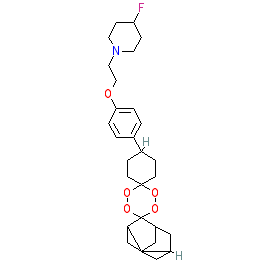|
Compound class:
Synthetic organic
Comment: E209 is a fully synthetic tetraoxane analogue with potent antimalarial activity [1].
The Malaria tab on this ligand page provides additional curator comments of relevance to the Guide to MALARIA PHARMACOLOGY. |
|
|||||||||||||||||||||||||||||||||||
| Guide to Malaria Pharmacology Comments |
| E209 demonstrates a fast parasite killing profile against P. falciparum (log PRR of >4.8) when measured using an in vitro parasite reduction ratio (PRR) assay and is similar to that of artemisinin and faster than chloroquine, including no lag phase in the killing curve [1]. Potential Target/Mechanism Of Action: As the precise mechanism of action of E209 is not yet known, we do not have a molecular target for this compound. |








